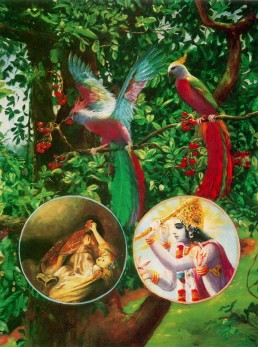Swami Chinmayananda
Swami Chinmayananda Commentary
OF THE DEVARISHIS I AM NARADA — Of the heavenly Seers, Krishna describes Himself as Narada, a favourite figure in our legends. In our Puranas, Narada is described as a great devotee of Hari; he is not only a great Seer among the celestials, but he often comes down to the world to play the deliberate fool and ultimately guide the deluded mortals to the parlour of heaven. Perhaps Krishna, himself being a great missionary, entertains a great respect for Narada, because of his missionary zeal and enthusiasm. Many are the converts whom Narada has won for heaven as described in our Puranas. A missionary cannot but feel a comradeship with another working in the same field and nothing can create a greater tie of identification than the similarly of aspiration in two individuals.
‘Gandharvas’ are the mythological concept of subtle entities who constitute the celestial choir, who entertain the denizens of heaven with their art and music. They are the ‘stars’ of entertainment in heaven. Among them, Chitraratha is the most brilliant.
OF THE SIDDHAS, I AM THE MUNI KAPILA — These Siddhas are not magic-mongers. The term Siddha in Sanskrit indicates one who has “achieved the Goal (Sadhya)” and therefore, it means the “Perfected One.” Among Men-of-realisation, therefore, Krishna says, “I am Muni Kapila.” The term Muni need not bring into our mind the traditional picture supplied by illiterate painters of an aged, silver-haired, almost naked fakir, generally roaming about where others will not dare to enter, eating a strange diet, a strange creature of the forests, rather than a decent normal man of the town. Muni is a term in Sanskrit derived from the word Manana which is the “art of reflection.” The term Muni, therefore, only means a thinker; “OF THE THINKERS I AM KAPILA.”
Kapila, the author of the Sankhya philosophy has been here particularly singled out for this great status as the best among all thinkers, because the Geeta mainly follows the Sankhyan-philosophical thoughts.
The Lord uses the framework of thoughts in the Sankhya philosophy to paint His concept of the One Truth, Absolute and Eternal, and therefore, Kapila, the promoter of the Sankhyan school of thought, has been given the special glory of being compared with the Lord Himself.
FEELING THAT HE HAS NOT DELIVERED THE GOODS YET, THE LORD CONTINUES:
Adi Sankara Commentary
Sarva-vrksanam, among all trees, (I am) the Asvatta; and Narada devarsinam, among the divine sages-those who were gods and became sages by virtue of visualizing Vedic mantras; among them I am Narada. Gandharvanam, among the gandharvas, I am the gandharva called Citraratha. Siddhanam, among the perfected ones, among those who, from their very birth, were endowed with an abundance of the wealth of virtue, knowledge and renunciation; (I am) munih, the sage Kapila.
The Bhagavad Gita with the commentary of Sri Sankaracharya – Translated by Alladi Mahadeva Sastry
Holy Geeta – Commentary by Swami Chinmayananda
The Bhagavad Gita by Eknath Easwaran – Best selling translation of the Bhagavad Gita
The Bhagavad Gita – Translation and Commentary by Swami Sivananda
Bhagavad Gita – Translation and Commentary by Bhaktivedanta Swami Prabupadha
Srimad Bhagavad Gita Chapter 10 – Verse 26 – 10.26 asvatthah sarvavrksanam – All Bhagavad Gita (Geeta) Verses in Sanskrit, English, Transliteration, Word Meaning, Translation, Audio, Shankara Bhashya, Adi Sankaracharya Commentary and Links to Videos by Swami Chinmayananda and others – 10-26

